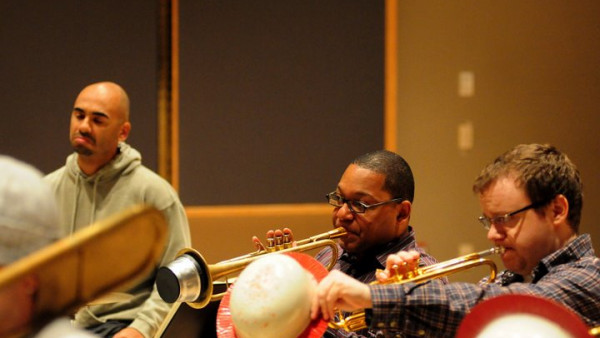Experiencing America, With Foot and Instrument
The climax of the Alvin Ailey American Dance Theater’s 50th-anniversary season, which has emphasized live music, has arrived in the middle of its run, with two programs whose first two-thirds are each to music by Duke Ellington. To play these, Wynton Marsalis (on trumpet) and the Jazz at Lincoln Center Orchestra (conducted by Eric Reed, some 19 musicians in all) occupy the back of City Center’s stage.
It’s a thrill to hear the big-band sound projecting through the theater. At some moments the brass section comes in like a massive wall of sound; at others its long chords hang in the air like clouds. Dan Nimmer (on piano) and Carlos Henriquez (on bass) are marvelous sources of rhythm. Ellington called his work “American music” rather than jazz, and throughout these two programs you hear how he took the American jazz roots of his style and pushed them into aspects of classicism, European modernism and more.
This American-based diversity is one reason that Ellington was so often the composer to whose scores Ailey chose to choreograph. Both of these current Ailey-Ellington programs show the range of styles that Ailey could use. The hip-tilting jazz dance that is the main idiom of “Night Creature” (1974) is far from the controlled, modern-dance adagio of “Reflections in D” (1962), even though some of the same steps occur in both. In “Night Creature” you feel Ailey’s dancers surfing the wave of the music; in “Reflections” you feel the male soloist rigorously, soberly countering it.
Those two begin Program A. Program B starts with “The River” (1970). Ailey and Ellington shaped this together; it originally had its premiere with American Ballet Theater (the Ailey company dances it without point work), and it is a spectrum of styles, speeds and tempers. The middle part of each program is the same: two sections from the choreographer Talley Beatty’s “Road of the Phoebe Snow” (1959), whose music is by Ellington and Billy Strayhorn; a duet from “Caravan” (choreographed in 1976 by Louis Falco to music based on Ellington themes by Michael Kamen); and single excerpts from three of Ailey’s compositions to Ellington music: “The Mooche” (1975), “Pas de Duke” (1976) and “Three Black Kings” (also 1976, to music of that title composed by Ellington and his son, Mercer).
Continue reading the main story
RELATED COVERAGE
slideshow
Alvin Ailey Celebrates 50 Years JULY 28, 2010
DANCE REVIEW | ALVIN AILEY AMERICAN DANCE THEATER
An Ailey Premiere Features Sweet Honey in the Rock at City Center DEC. 7, 2008
DANCE
Remembering Alvin Ailey on the 50th Anniversary of His Company NOV. 28, 2008
Alvin Ailey – Alvin Ailey American Dance Theater – Dance – Celebration MARCH 27, 2008
TIMES TOPIC
Alvin Ailey
None of the choreography in any of these Ellington works is great, and only occasionally do we hear even Ellington at his best. But the program makes me happy to be in his and Ailey’s company: they both have range, craftsmanship, warmth and largeness of spirit. Ailey in several works relies on repetition of the same basic dance ingredients, and even though you know you’re seeing the same move again and again, it’s impressive how often he makes it appealing.
Those steps we see so often across the repertory — the backbend with one leg extended out front; the slow, backward falls controlled through the legs alone; the double turns with one leg raised and angled behind (“attitude back”); the undulations through the torso; the dives into downward-leaning arabesque where the body turns from facing down to sideways (or vice versa) — are all juicily full-bodied. I have called several Ailey works thin, but that’s not quite the right adjective when they’re made up of movement so rich in texture.
In “Night Creature” you see the same jazzy side-tip of the hips a zillion times, and yet how kinesthetically it always communicates itself, how sensuously you feel the stress of the pelvis moving away from the upper abdomen. I always want to go home and practice it on my way to bed.
I speak in these general terms of the Ailey repertory because no work leaves a very specific impression, though Ailey was always enough of an artist to make one perfectly distinct from another. The great exception is, of course, “Revelations,” where even the repetitions become a ritual expression of spiritual urgency and exaltation.
It is not unusual to see certain Ailey performers dance one or more solo roles every night. Among these, Matthew Rushing grows only more exemplary as the season develops: he is applying less facial overlay and, if possible, even more physical commitment to all his roles.
Linda Celeste Sims has often appeared in three or four works per program without any sign of stress; although her dancing could sometimes be fuller, her warmth and glamour are marvelous.
Although Clifton Brown is probably the company’s most technically powerful dancer (he looks, however, less refined than last year), he often plays his roles as if he’s telling us what a great time he’s having onstage — bright smiles and brighter eyes — and so seems the least grown-up person in the company.
All the Ailey performers are marvels in focus — his choreography often asks them to address several different points in quick succession — but none more so than Amos J. Machanic Jr., who has danced “Reflections in D” and (in “Revelations”) the “I Wanna Be Ready” solo with a rapt innocence that is immensely touching.
by Alastair Macaulay
Source: New York Times

